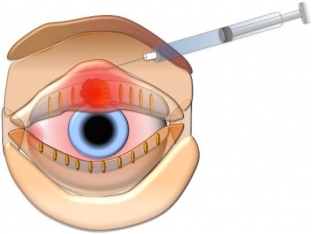Chalazion, or meibomian cyst, is an inflammation of the cartilage of the eyelid, in which the meibomian gland becomes blocked and stops secreting, or a viscous secret continues to flow, but So slow. The clogged gland swells, and & nbsp; the resulting ball on the eyelid, fused with cartilage, can be the size of a bean. A chalazion can form in the thickness of the eyelid in just a few hours. At the same time, the inflammation proceeds completely painlessly for the patient and has a benign course with a good prognosis.
Reasons why a chalazion develops in the eyelid
Chalazion is quite common, the disease affects people of different sex and age, but it still affects young people more often, since the sebaceous glands of the eyelid work less intensively in older patients. The disease is not hereditary in any way and does not depend on any tendency to inflammation.
Among the reasons why inflammation of the cartilage of the eyelid and blockage of the meibomian gland can occur are the following:
- hypothermia and colds;
- weakening of the body's defenses, especially after previous illnesses;
- wearing contact lenses;
- violation of the rules of personal hygiene in facial care;
- frequent eye rubbing;
- transferred stye on the inside of the eyelid.
The presence of increased oily skin in the patient can provoke the appearance of chalazilon: in this case, the meibomian glands work especially intensively, and increased secretion can cause blockage of the lacrimal outflow.
Peculiarities of chalazion manifestation and diagnostic difficulties
Chalazion is manifested by the appearance of a dense ball on the eyelid, similar to a millet grain or a small pebble under the skin. The essence of the phenomenon is that the meibomian gland swells in the thickness of the eyelid, lifts the skin and deforms the eyelid. The formation is soldered to the touch with the cartilage, but the skin above it moves easily, and the nodule itself is completely not painful, elastic and dense, does not move from its place.
In the area of the chalazion, on examination, an elevated conjunctiva that is thickened and inflamed can be observed. Sometimes it is perforated, and the contents of the nodule come out. It happens that the opening of the nodule occurs through the skin. But in any case, after the release of the contents, the granulation tissue of the chalazion does not disappear anywhere and grows in the subcutaneous fatty tissue. If the chalazion does not open on its own, it can become a thick-walled cyst.
Patients go to the doctor with complaints of redness of the eyelid and its swelling, sometimes a large chalazion begins to put pressure on the eyeball. Differential diagnosis should be carried out with neoplasms, exclude basal cell carcinoma.
Chalazion treatment and possible prognosis for the patient
If the chalazion is small, absorbable therapy with hydrocortisone ointment, disinfectant drops, and steroid injections gives a good effect. A nodule with a diameter of more than 5 mm is not amenable to conservative treatment and must be removed surgically. The chalazion is excised from the side of the mucous membrane of the eye, the contents of the cyst are scraped off, the cavity is treated with a disinfectant, then an antibacterial ointment is applied behind the eyelid, and a pressure bandage is applied to the eye. If possible, removal is performed along with the capsule, since the chalazion tends to recur. The operation is performed under local anesthesia and does not leave cosmetic defects, since the incision is made from the inside of the eyelid.

Strengthening the body's defenses serves as a preventive measure against relapses of the disease. But in recurring cases of chalazion, a biopsy is recommended to rule out the possibility of cancer.







Add a comment